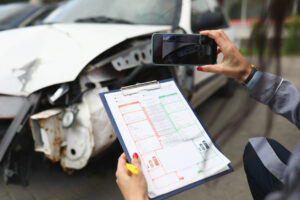
Knowing how and why car accidents happen can improve vehicle safety and traffic law enforcement. It also helps auto insurers and personal injury lawyers identify the driver responsible for the collision.
Many factors can combine to create the conditions for a traffic crash. Most collisions are a consequence of risky driving behaviors. However, surface conditions, visibility, and traffic congestion can make roads less forgiving, turning a momentary lapse into a life-changing crash.
Top Contributing Factors to Car Collisions

The causes of a car accident are usually recorded in the crash report. The investigating officers will piece together the contributing factors based on interviews with the drivers and witnesses. They will also use the position of the vehicles and the nature of the crash damage to identify anything that contributed to the crash.
Using these reports, the National Highway Traffic Safety Administration (NHTSA) performed a groundbreaking study that found 94% of traffic accidents resulted from driving errors. Only 2% of crashes resulted from environmental conditions, and 2% happened due to vehicle problems.
California has performed similar studies. According to the state’s Department of Transportation, the leading causes of car accidents include driver behaviors, such as intoxicated driving and speeding.
What is the most common cause of collisions? Based on these sources, the top causes of car accidents in California include the following:
Intersection Violations
In California, the most common cause of a collision is an intersection violation. According to the state’s analysis, 43% of the state’s traffic deaths occur at intersections. San Diego does slightly better, with 42% of the city’s fatalities happening at intersections. Even at 42%, this number is shockingly high.
These crashes typically involve two dangerous driving behaviors:
- Failing to yield the right of way
- Disobeying traffic signs or signals
These traffic violations typically occur in the following ways:
- Going out of turn at a two or four-way stop
- Turning left across the path of an approaching vehicle
- Turning right or proceeding through an intersection without waiting for a gap in traffic
- Running a red light or stop sign
- Entering a crosswalk occupied by a pedestrian or bicyclist
An intersection collision often involves an angle or side impact. These collisions are particularly dangerous when they happen on the vehicle’s door because the impact can cause the door to collapse and crush the vehicle’s occupants.
Speeding
Speeding and aggressive driving caused 30% of traffic accidents in San Diego. Drivers can speed in two ways. First, they can exceed the speed limit, which is typically set based on the type of road and its surroundings. For example, residential roads in California typically have a speed limit of 25 miles per hour.
When drivers exceed the speed limit, they risk hitting drivers, pedestrians, or cyclists who expect the driver to maintain a slower, safer speed. They also significantly increase the collision energy of the crash, possibly resulting in more severe injuries.
Second, a driver can speed by driving too fast for the environmental conditions, even though they are traveling below the speed limit. Some situations in which a driver might drive too fast for conditions include the following:
- Wet or sandy roads
- Poor visibility
- High wind
In these situations, the driver can lose control of their vehicle. For example, a speeding driver might end up sliding sideways if they try to turn a corner too fast while driving on a slick road.
Intoxicated Driving
Intoxicated driving is not as common as other traffic violations. However, it is California’s second leading cause of fatal car accidents. Drugs and alcohol can affect a driver in the following ways:
- Dulling their reactions
- Impairing their judgment
- Altering their perception of time, distance, and speed
- Causing drowsiness
Contrary to popular belief, intoxicated drivers can die in the drunk driving accidents they cause. Additionally, since they often fail to react before colliding, they can seriously injure or kill other road users.
Distracted Driving
According to a survey by the California Office of Traffic Safety, over 74% of Californians identified distracted driving as their most significant traffic safety concern. However, distracted driving was only cited as a cause in 3% of San Diego’s fatal traffic crashes. Identifying a distracted driver after a fatal crash is difficult because distractions often leave no evidence.
Distracted driving happens when drivers attempt to multitask. Any activity that takes a driver’s eyes, hands, or focus away from driving reduces their ability to react to traffic or road hazards. Although many people blame texting and driving for an increase in crashes, drivers also engage in many of the following activities that can be equally distracting:
- Talking to passengers or on the phone
- Eating or drinking
- Adjusting the stereo
- Watching videos
- Reaching for something
Bear in mind that a driver can commit distracted driving without violating the law. For example, California has no laws against rubbernecking, but a driver distracted by another crash can cause a crash of their own.
Inattention
Inattentive driving is slightly different from distracted driving. Distracted driving happens when a driver’s abilities are impacted by another activity that interferes with their driving. Inattentive driving happens when a driver fails to focus on driving. Some common causes of inattentive driving include the following:
- Highway hypnosis
- Anger
- Fatigue
- Daydreaming
The statistics do not separate inattentive and distracted driving. However, many cases blamed on distractions actually arose from inattention.
Some ways that inattention may manifest on the road include:
- Improper lookout
- Lane drift and road departures
- Unsafe lane changes
- Tailgating
Like distracted driving, inattentive driving often leaves no evidence. Instead, police officers, claim adjusters, and injury lawyers must rely on eyewitness testimony and circumstantial evidence, such as a lack of skid marks, to prove inattention.
Carelessness
In a sense, all driving errors arise from carelessness. In fact, a car accident lawyer must prove the at-fault driver’s lack of reasonable care to recover compensation for injured clients. However, carelessness may be more directly related to a collision. Some careless actions that can lead to a crash include:
- Failing to check blind spots before changing lanes
- Executing a rolling stop at a stop sign or red light
- Trying to beat pedestrians crossing the road instead of yielding
In any of these situations, the driver’s impatience and lack of regard for the safety of others can lead to crashes.
Contact a San Diego Car Accident Lawyer for a Free Consultation
If you were injured in a car accident due to another driver’s error, you may be entitled to compensation. Contact Pines Salomon Personal Injury Lawyers at (858) 551-2090 for a free consultation to discuss liability for your car accident.
